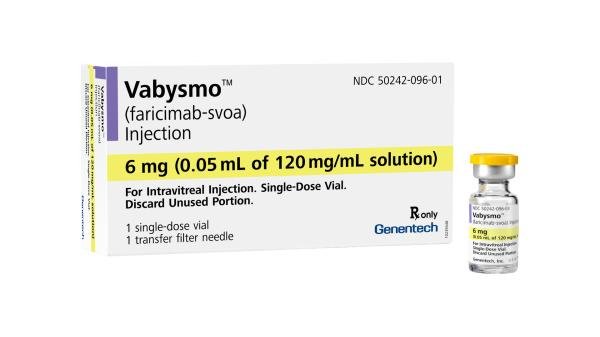Vabysmo Side Effects
Generic name: faricimab ophthalmic
Medically reviewed by Drugs.com. Last updated on Sep 28, 2024.
Note: This document provides detailed information about Vabysmo Side Effects associated with faricimab ophthalmic. Some dosage forms listed on this page may not apply specifically to the brand name Vabysmo.
Applies to faricimab ophthalmic: intraocular solution.
Precautions
Your eye doctor will want to check your progress at regular visits, especially during the first few days after you receive this medicine, to make sure this medicine is working properly and to check for unwanted effects.
Receiving this medicine while you are pregnant can harm your unborn baby. Use an effective form of birth control to keep from getting pregnant during treatment and for at least 3 months after the last dose. If you think you have become pregnant while receiving this medicine, tell your doctor right away.
Serious eye or vision problems (eg, eye infection, retinal detachment, retinal vasculitis, or retinal vascular occlusion) may occur with this medicine. Check with your eye doctor right away if your have blurred or other change in vision, eye pain, eye redness, headache, seeing flashes or sparks of light, seeing floating spots before the eyes, or a veil or curtain appearing across part of vision, or tearing of the eyes several days after you receive this medicine. Also, tell your eye doctor if you feel increased pressure in your eye.
This medicine may increase your risk of blood clots, heart attack, or stroke. Check with your doctor right away if you are having pain in your chest, groin, or legs, especially the calves, difficulty or trouble breathing, a severe, sudden headache, slurred speech, sudden loss of coordination, sudden, severe weakness or numbness in your arm or leg, or vision changes.
This medicine may cause temporary blurred vision. Do not drive or do anything else that could be dangerous until you can see clearly.
Serious side effects of Vabysmo
Along with its needed effects, faricimab ophthalmic (the active ingredient contained in Vabysmo) may cause some unwanted effects. Although not all of these side effects may occur, if they do occur they may need medical attention.
Check with your doctor or nurse immediately if any of the following side effects occur while taking faricimab ophthalmic:
More common side effects
- bloody eye
- redness of the eye
Less common side effects
- blurred vision
- change in vision
- eye pain
- loss of vision
- red, sore eyes
- seeing floaters, veil or curtain appearing across part of vision
- seeing floating dark spots or material before the eyes
- tearing
Rare side effects
- eye irritation
- seeing light flashes
- watering of the eyes
Incidence not known
- chest pain, discomfort, or tightness
- fast heartbeat
- fever
- hives, itching, rash
- hoarseness
- irritation
- joint pain, stiffness, or swelling
- nausea
- pain or discomfort in the arms, jaw, back, or neck
- redness of the skin
- stroke
- sweating
- swelling of the eyelids, face, lips, hands, or feet
- trouble breathing
- vomiting
See also:
For healthcare professionals
Applies to faricimab ophthalmic: intravitreal solution.
General adverse events
The most common adverse reactions occurring in greater than 5% of patients included cataract and conjunctival hemorrhage.[Ref]
Cardiovascular
- Common (1% to 10%): Arterial thromboembolic events
Arterial thromboembolic events were defined as as nonfatal stroke, nonfatal myocardial infarction, vascular death [including deaths of unknown cause.
In the neovascular age-related macular degeneration studies (nAMD), arterial thromboembolic events (ATEs) were reported in 1% of patients during the first year. In the diabetic macular edema studies, ATEs were reported in 5% of patients from baseline to week 100. In the retinal vein occlusion studies, ATEs were reported in 1.1% of patients during the first 6 months.
Hypersensitivity
- Frequency not reported: Hypersensitivity reactions
Immunologic
- Very common (10% or more): Anti-drug antibodies (up to 10.4%)
Ocular
- Very common (10% or more): Cataract (up to 15%)
- Common (1% to 10%): Conjunctival hemorrhage, eye pain, increased intraocular pressure, increased lacrimation, retinal pigment epithelial tear (nAMD only), vitreous floaters, vitreous detachment, intraocular inflammation, eye irritation, ocular discomfort
- Uncommon (0.1% to 1%): Blurred vision, corneal abrasion, conjunctival hyperemia, endophthalmitis, eye pruritus, iridocyclitis, iritis, ocular hyperemia, retinal tear, sensation of foreign body, uveitis, reduced visual acuity, vitreous hemorrhage, vitritis
- Rare (0.01% to 0.1%): Rhegmatogenous retinal detachment, transiently reduced visual acuity, traumatic cataract
Postmarketing: Retinal vasculitis with or without retinal vascular occlusion
Intraocular inflammation included iridocyclitis, iritis, uveitis, and vitritis.
Other
- Uncommon (0.1% to 1%): Procedural pain
References
1. (2024) "Product Information. Vabysmo (faricimab ophthalmic)." Roche Products Ltd
2. (2024) "Product Information. Vabysmo (faricimab ophthalmic)." Genentech
3. (2024) "Product Information. Vabysmo (faricimab ophthalmic)." Roche Products Pty Ltd
Frequently asked questions
More about Vabysmo (faricimab ophthalmic)
- Check interactions
- Compare alternatives
- Pricing & coupons
- Reviews (39)
- Drug images
- Dosage information
- During pregnancy
- FDA approval history
- Drug class: anti-angiogenic ophthalmic agents
- Breastfeeding
- En español
Patient resources
Professional resources
Related treatment guides
Further information
Vabysmo side effects can vary depending on the individual. Always consult your healthcare provider to ensure the information displayed on this page applies to your personal circumstances.
Note: Medication side effects may be underreported. If you are experiencing side effects that are not listed, submit a report to the FDA by following this guide.

